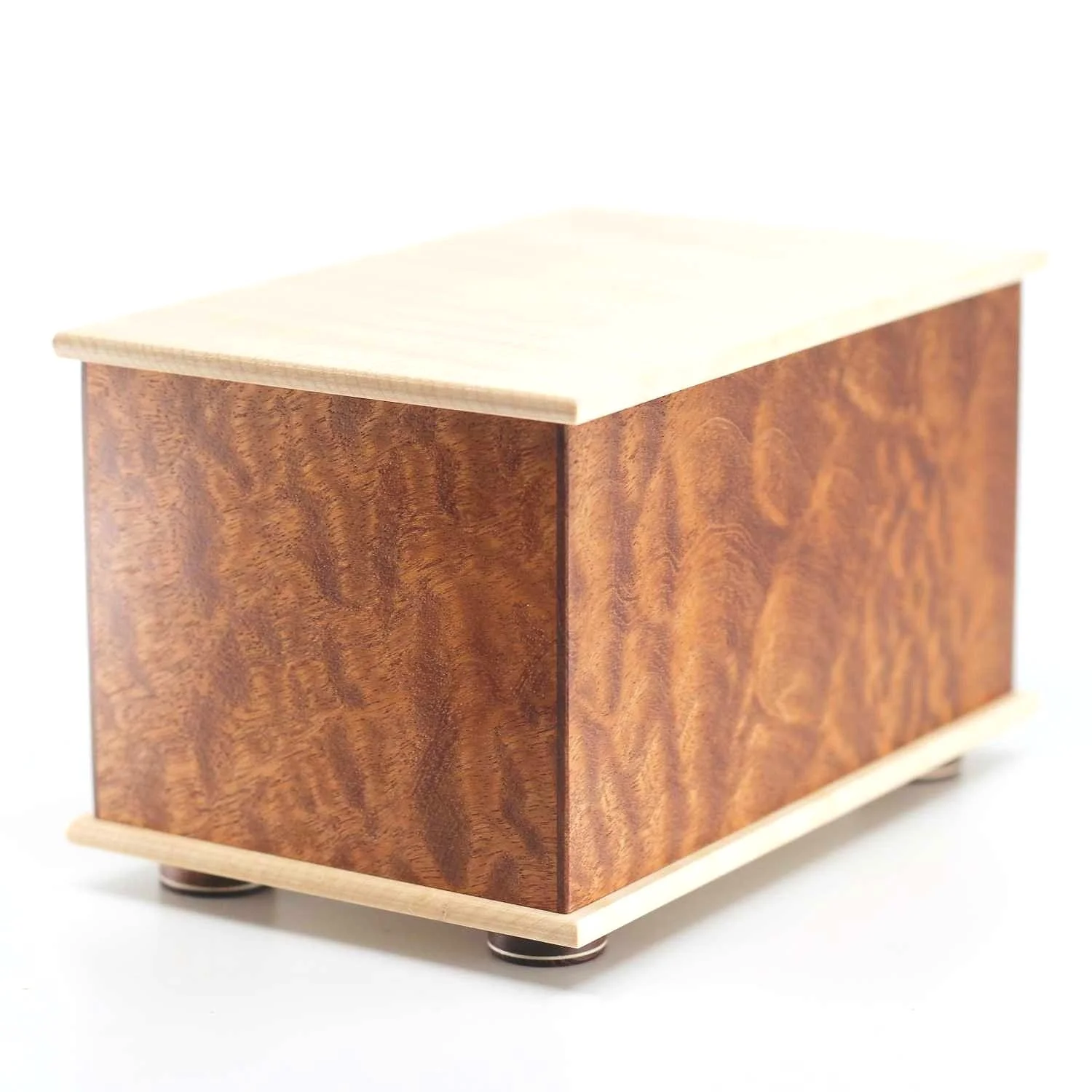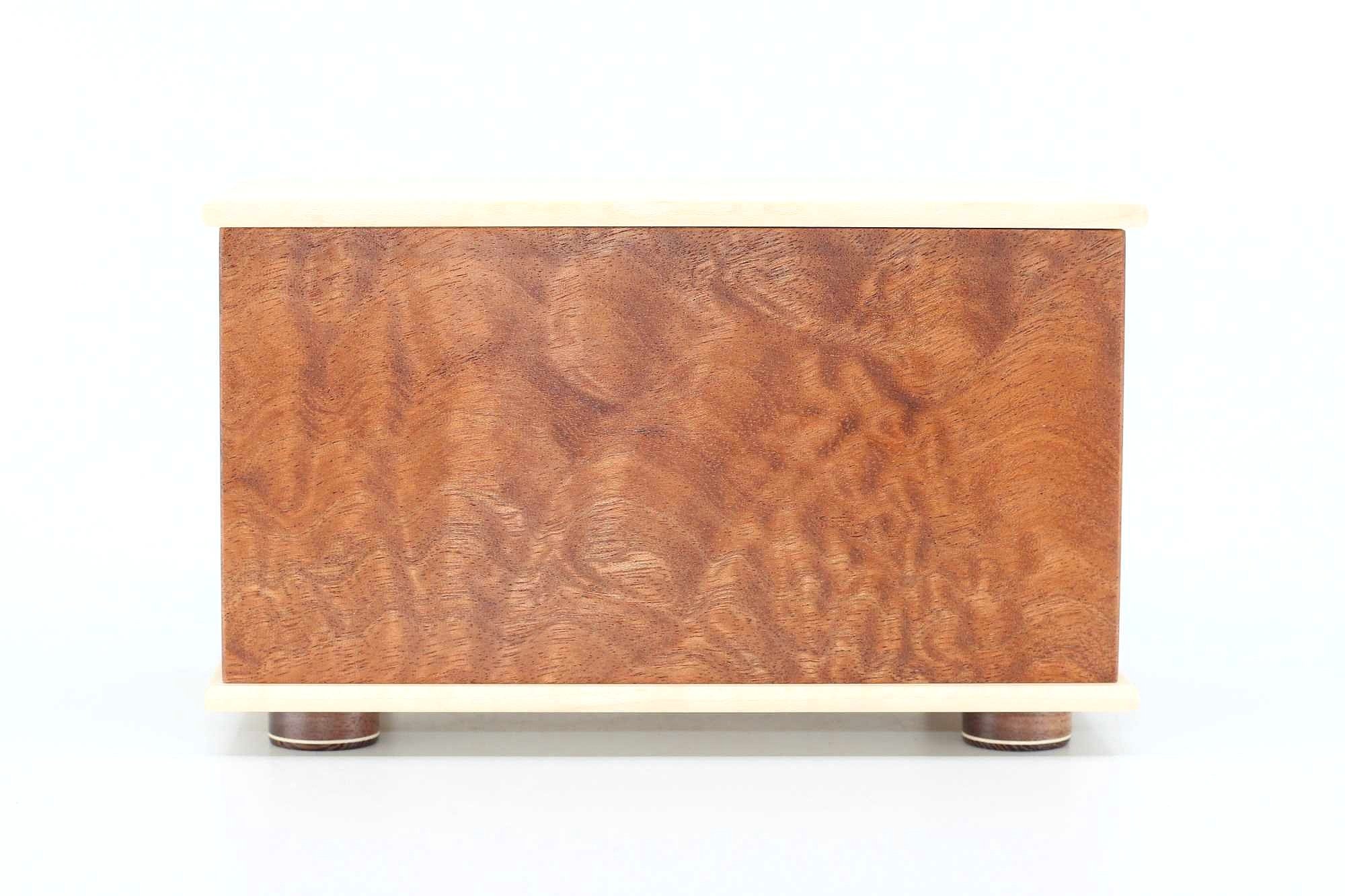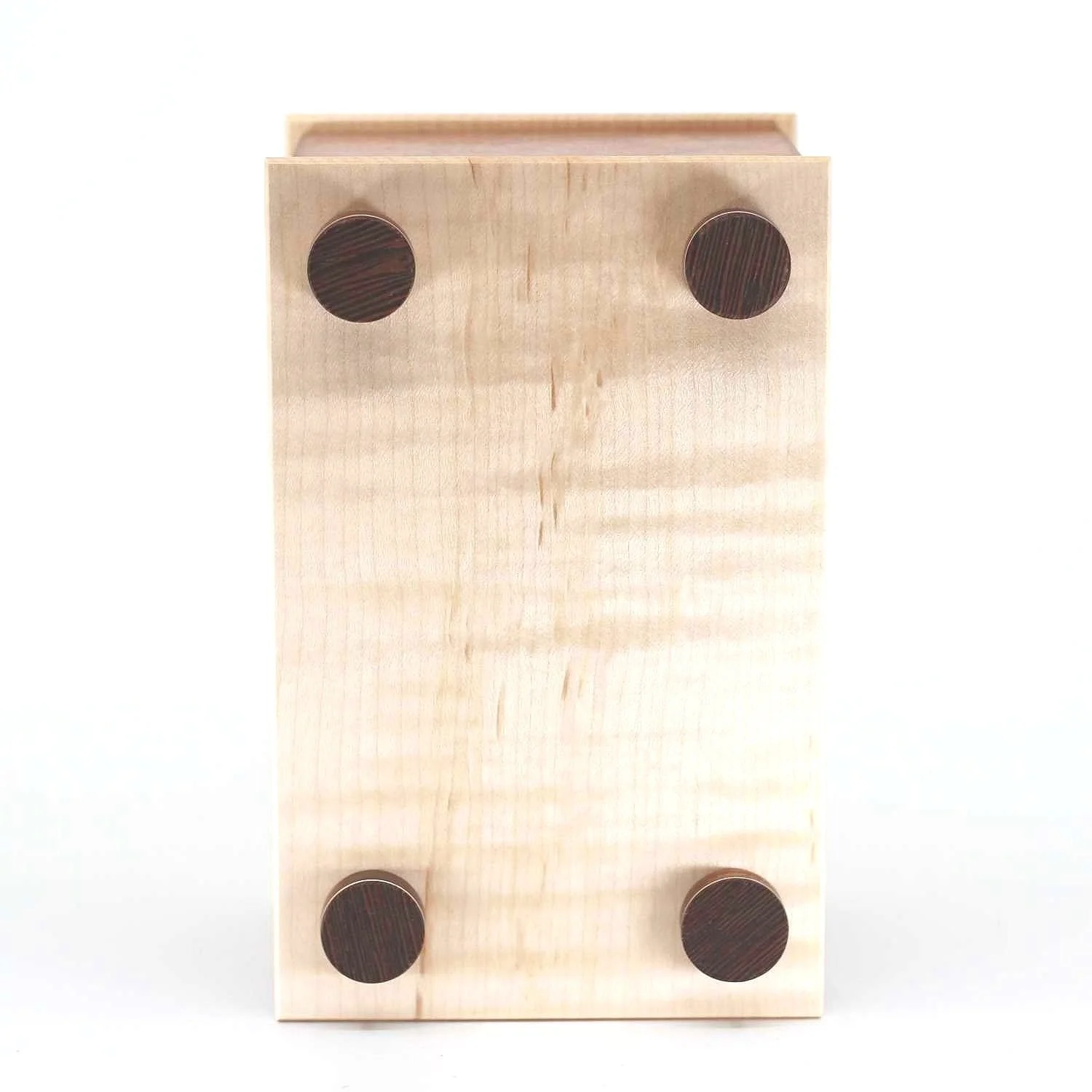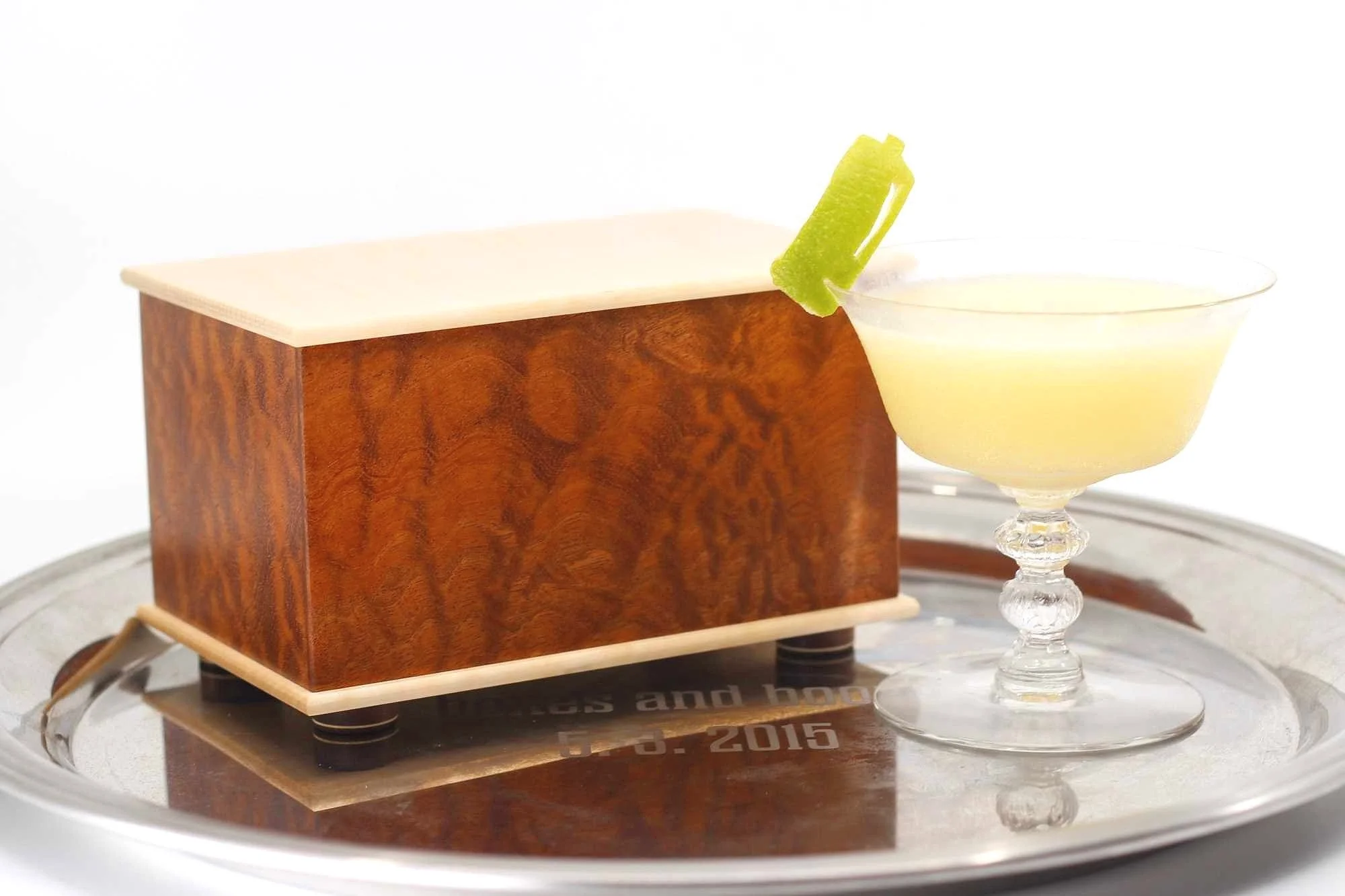What about BOB?
Battery Operated Box
Battery Operated Box by Kagen Sound
Kagen Sound is trying something new. The American master of finely crafted secret opening boxes is incorporating electronics now, but at least in this case, the batteries are included. And while it may seem, after experience his newest creation, like this new direction must be true, rest assured there are no actual electronics to be found. Kagen explains: “With every design I do I am trying to push myself in a new direction. For this box I had a gut feeling about the concept of a “magic trick”. It wasn’t initially more specific than that.” Kagen compares the puzzle box to a Karakuri box, the term that the Japanese Karakuri Creation Group founder Akio Kamei coined for his marvelous brand of artistry.
“I greatly admire Akio Kamei and his ability to create a sort of magic in his classic designs like Cassiopeia and Box with a Key, which at their core have a riddle which needs to be solved, and which seem to work like magic when the riddle is solved. These boxes open once you understand and perform the riddle. They are elegant pieces which contain the sense of an interactive magic trick.”
“My work is normally very abstract and follows a relatively obvious sequence of movements,” even when the sequence may be quite tricky. Yet here we have a box that comes with literal wooden batteries! It’s reminiscent of Kagen’s rare “Hatter’s Box”, which hides a Mad Hatter’s hat inside. “This box felt like the most literal design I have ever made. I usually stay away from such designs, but this time the batteries were such a pretty form and embodied a universal symbol of power, or power source, in their simple elegant shape. It was such a nice, literal metaphor to use. The rest of the box is still very abstract, which stays true to my roots.”
The goal was to give people that feeling of fun, of trying to solve the riddle of it. The name is also an homage to Kamei, it’s a very Kamei-esque type of name, quite literal and self-explanatory, while still retaining enough of the riddle to be a bit mysterious. “I was concerned or worried that [the box] was still too abstract. I purposely described the box as magical to guide the solver.” This is also something Kamei has done in his descriptions.
The box went through a number of prototypes and iterations all aimed at making the “magic” just right in the final production. I won’t mention specifically what was changed or added to the design to avoid giving unintentional clues, but the goal for Kagen was to create a highly consistent mechanism and solve experience. One feature which is notable on immediate exploration of the box, the moment it is held, is that the lid wiggles a bit, lifting up slightly but obviously locked in place. This was a very interesting intentional design feature that Kagen actually added later. The original lid was tight and flush, and testers would ignore it and not imagine it could lift off. Kagen redesigned it to move just slightly, to actually loosen the fit of the lid, something very counterintuitive to his typical design process. The slight movement serves as another clue, or objective, and heightens the experience, according to Kagen, an observation based on many iterations of tester feedback. Kagen understands and appreciates the psychology built into a good puzzle box, and will seek to exploit it for an improved overall experience.
Kagen had been thinking about making a box which uses this magical mechanism for a while. He had also been thinking about making a fun Karakuri type box. Previously these ideas were always too literal for him, too far out of his comfort zone. But somehow the idea of solid wooden batteries became too compelling to ignore – it was too good to pass up and the time was finally right for him to “challenge myself to think that way, out of my comfort zone with a more literal, riddle type box. I wasn’t quite sure it was possible.” But then he made one. “Ok, I can make it work once. Can I duplicate it over 20-30 copies?” Many iterations and changes were made along the way to deal with reliability and inherent changes which occur in wood like warping that could disrupt the mechanism and be unreliable. Parts of the box were changed, and even the initial batteries had to be remade. “The original wood used was Tasmanian Blackwood, which has a sort of sign wave patterned grain running lengthwise through it (it is a curly grained wood). Humidity increased the length of this wood slightly due to the grain pattern, which was something unexpected, and essentially rendered the batteries inoperable. It was an interesting problem to face.” He pivoted to using straight grained Cocobolo, and in the end loved the Rosewood better anyway, which was more colorful and special when contrasted with the sapele wood of the box body. The woods used in the box also have a story. The sapele for the box is from the same board used on the Lotus Tables. Kagen keeps all the old fragments and boards from his projects over the years, and even the scent of the wood recalls the old projects and his memories of making them. There is a little bit of ebony in the box from the Lotus Table as well. The feet in the box have a bit of green Lignum Vitae wood detail running through them, which was a leftover, unused part from the Pipe Organ Desk.
Kagen suggests that this box can be used as an actual performative magic trick, and has done that for his friends. He notes that there is an overlapping of certain puzzle boxes and magic tricks, a shared space or common zone, and this box falls into that space. The Battery Operated Box is part of a “literal” box series which follow the Karakuri-esque riddle theme. The next two boxes he has planned will be companions. All of his new boxes have been designed around “sequential discovery” of a tool (usually a single tool) needed and used to open the box somehow, and will include the “Coin Operated Box” and another yet to be disclosed box, which will come in an easy and harder version. The easy version will be more of a functional box with an elegant and appealing opening mechanism, mostly meant for non-puzzlers. Kagen plans to continue to push the functionality and limitations of wood and mechanism in his future creations.
Triple A by Dick Bradsell
The toast to the elegant Battery Operated Box pays homage to another master of his craft. Dick Bradsell was a legendary and influential bartender in London who played no small part in the cocktail renaissance of the late nineties and early aughts. He died in 2016 at the fairly young age of 56 and left behind the many famous cocktails he invented, including the Bramble, the Green Fairy, and the ever popular Espresso Martini. He was passionate about a finely crafted daiquiri, that perfectly simple combination of rum, lime and sugar, and would use it as a test of skill for vetting a good bartender. He described the ideal daiquiri experience, harkening back (in his mind) to nineteen thirties Cuba at La Floridita Bar: “Smooth aged Havana rum blended with fresh limes – that have been hand squeezed whilst wearing white cotton gloves so not a drop of the oil from the skin will taint the concoction. Sugar syrup and maraschino liqueur added, the mix flash blended and then strained through a wire mesh meticulously into a prechilled oversized cocktail glass before being set lovingly in front of the lucky customer. I pause to salivate.”
plenty of juice in this battery
Dick’s good friend Theresa Sutton explained his inimitable style. “He adopted the protective carapace of the formal English bartender – one part Jeeves, one part Lloyd from the Shining, one part eccentric schoolmaster and a dash of surrealist poet”. His Triple A cocktail is not as well known as some of his creations, but like all of his cocktails it is surprising, robust and perfectly well balanced. It’s named after the ingredients – absinthe, apple and almond – and not the battery, but it was still the perfect pairing here. It may well be the most interesting and tasty absinthe forward cocktail I’ve had in a long time. I would not have imagined that apple juice would pair with absinthe so well. It’s just another testament to Dick’s skill and work ethos - “Perfection in bartending doesn’t just happen; you have to make the effort.” Cheers!
Batteries included
Triple A by Dick Bradsell
1 oz absinthe
1 oz chilled water
1 oz fresh press apple juice
½ oz orgeat
¼ oz lime
Shake ingredients together with ice and strain into a favorite glass. Lemon twist garnish.
explore more:








